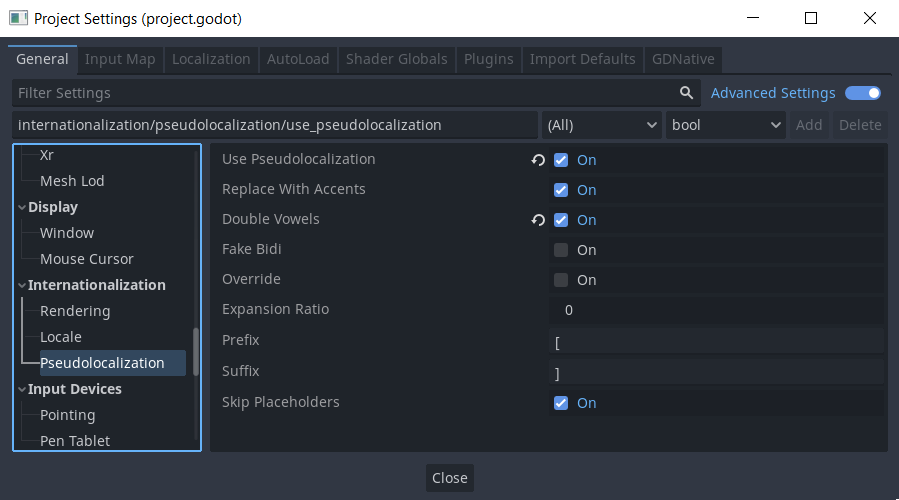Attention: Here be dragons
This is the latest
(unstable) version of this documentation, which may document features
not available in or compatible with released stable versions of Redot.
Checking the stable version of the documentation...
Pseudolocalization¶
Introduction¶
When creating a game, the process of localization usually starts when development has finished. This means that translations aren't available during development for testing whether the project is internationalized properly.
Redot offers pseudolocalization as a way to test how robust the project is when it comes to locale changes. Pseudolocalization simulates changes that might take place during localization. This way, any issues regarding internationalization can be recognized early on during development.
See also
You can see how pseudolocalization works in action using the Pseudolocalizaton demo project.
Enabling and configuring pseudolocalization¶
Enabling pseudolocalization and the configurations related to it is as simple as toggling a checkbox in the project settings. These settings can be found in Project → Project Settings → General → Internationalization → Pseudolocalization after enabling the Advanced toggle in the project settings dialog:

Pseudolocalization can also be toggled at runtime from a script.
Pseudolocalization configurations¶
Pseudolocalization in Redot can be set up according to the specific use case of the project. Here are the pseudolocalization properties that can be configured through project settings:
replace_with_accents: Replaces all characters in the string with their accented variants. "The quick brown fox jumped over the lazy dog" will be converted to "Ŧh̀é q́üíćḱ ḅŕôŵή f́ôx́ ǰüm̀ṕéd́ ôṽéŕ ŧh̀é łáźý d́ôǵ" when this setting is enabled. This can be used to spot untranslated strings that won't have accents, but is also useful to check for missing glyphs in the font(s) used by the project.double_vowels: Doubles all the vowels in the string. It is a good approximation to simulate expansion of text during localization. This can be used to check for text that would overflow its container (such as buttons).fake_bidi: Fake bidirectional text (simulates right-to-left text). This is useful to simulate right-to-left writing systems to check for potential layout issues that would occur in languages using right-to-left scripts.override: Replaces all the characters in the string with an asterisk (*). This is useful for quickly finding text that isn't being localized.expansion_ratio: Can be used in cases where doubling the vowels isn't a sufficient approximation. This setting pads the string with underscores (_) and expands it by the given ratio. An expansion ratio of0.3is sufficient for most practical cases; it will increase the length of the string by 30%.prefixandsuffix: These properties can be used to specify a prefix and suffix to wrap the text in.skip_placeholders: Skips placeholders for string formatting like%sand%f. This is useful to identify places where more arguments are required for the formatted string to display correctly.
All of these properties can be toggled as needed according to the project's use case.
Configuring pseudolocalization at runtime¶
Pseudolocalization can be toggled at runtime using the
pseudolocalization_enabled property
in TranslationServer.
However, if runtime configuration of pseudolocalization properties is required,
they can be directly configured using
ProjectSettings.set_setting(property, value)
and then calling
TranslationServer.reload_pseudolocalization()
which reparses the pseudolocalization properties and reloads the pseudolocalization.
The following code snippet shall turn on replace_with_accents and double_vowels properties
and then call reload_pseudolocalization() for the changes to get reflected:
ProjectSettings.set_setting("internationalization/pseudolocalization/replace_with_accents", true)
ProjectSettings.set_setting("internationalization/pseudolocalization/double_vowels", true)
TranslationServer.reload_pseudolocalization()